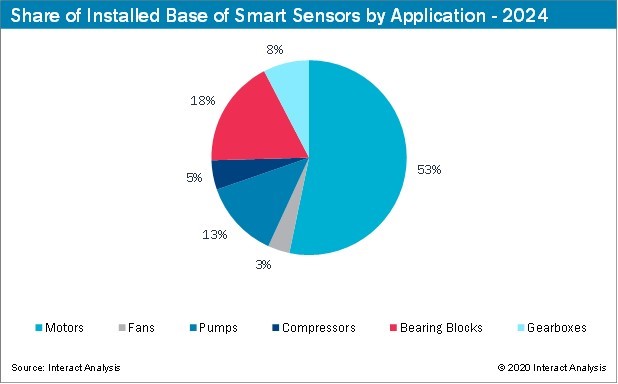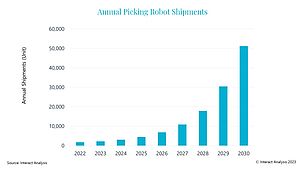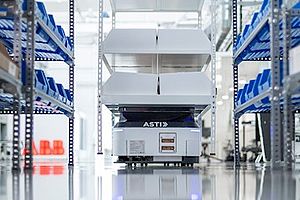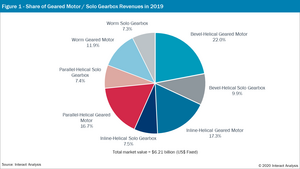A new generation of smart sensors, combined with highly advanced software algorithms, is pointing to a future where the failure of industrial machines can be predicted well before it happens; allowing preventative procedures to avert factory downtime. This is known as predictive maintenance, and it has been widely discussed for many years.
Recently, however, something has changed. I’ve studied the predictive maintenance market in depth, and my findings show that revenues associated with the market are now growing exponentially. By 2024, total market value will be $906m and, over our total forecast period, the market shows a CAGR of 40.6% (see Fig. 1).
So, what’s going on? The next generation tech that sits behind smart sensor and software offerings is part of the story; and I’ll discuss both below. But new business models are also crucial.
Predictive maintenance – the legacy
Predictive maintenance tends to be discussed in the context of IIoT and given this, it is easy to assume it is something relatively new. The reality is that it is not predictive maintenance that is new: what is new is that predictive maintenance is converging with the IIoT. The practice of predictive maintenance based on older technologies is already well embedded in certain industries.
A key legacy product that is already widely used for predictive maintenance is the portable monitoring device – handheld devices used to read the health of an industrial asset. Primarily, they are used on industrial motor driven systems to gather vibration, acoustic, electrical, or electromagnetic data by physically connecting the device to the system. This market was worth $120m in 2019, and growth is still forecast for the foreseeable future. Sure, IIoT-enabled predictive maintenance will eat into the portable monitoring device market a little, but mostly the new technology is focused on new market sectors.
Smart sensors
Smart sensors – small wireless devices with in-built computing power – are mostly based on capacitive MEMS technology. The key thing about MEMS technology is that it has dramatically come down in price, largely as a result of economies of scale achieved due to heavy use in consumer electronics. This, coupled with improvements in the amount of computing power that can be embedded on the sensor, has led to a surge in industrial predictive maintenance offerings. Battery life is similarly important: recent advances in battery energy density have led to sensors that can last several years.
The range of industrial components that a smart sensor can viably monitor has also been expanding. Up until now, electric motors have been the primary beneficiary. But as key technology constraints like limited bandwidth and high noise floor are overcome, we are seeing smart sensors being applied to a range of other areas, such as bearing blocks, gearboxes, and pumps (see Fig. 2).
IIoT systems increasingly depend on casting vast nets of smart sensors across entire factories. But, without sophisticated smart software to accompany them, they are of little value…
Smart software
For predictive maintenance to happen, intelligence must be applied to the data gleaned from sensors. In legacy systems, that intelligence tends to be of the human variety: maintenance technicians interpreting data gathered by portable monitoring devices. In an IIoT-enabled predictive maintenance system, which may involve hundreds or even thousands of data streams from individual sensors, more is required. All this data must be compiled into a historical log of how the equipment being measured has performed when it has previously headed towards a failure.
Machine learning algorithms are increasingly being applied, due to their ability to understand patterns, which leads to quick detection of data anomalies. This makes it much easier to monitor new applications that are not well understood, as well as increasing the notice operators have when machines are heading for failure. In rare cases, embedded machine learning is even happening on the sensor itself, allowing the sensor to determine which data is relevant before transmitting it to software for deeper analysis – this will be an important future growth trend.
New business models
The final part of the predictive maintenance problem has been for vendors to figure out how to make money out of it. While industrial equipment users want to extend the working life of their kit, there is a conflict of interest because it is clear that the longer that equipment working life is extended, the more industrial OEMs lose out on replacement revenue. The advent of predictive maintenance is forcing OEMs to learn how to maintain profitability without cannibalizing revenue.
Currently, predictive maintenance systems are often sold on a per unit basis: a price per sensor grants access to the necessary analytical software. This does not address the conflict of interest mentioned above, so its potential is limited.
Machines as a service (MaaS) is a promising new concept, similar to SaaS. Performance based pricing sees goals agreed in advance, with the price of the contract determined by to what extent goals are met. I’ve spoken to a number of vendors applying this model – such as Pearson Packaging.
MaaS is just one of a variety of new business models coming forward that will rapidly take us into an era where the majority of factories and machines use predictive maintenance as standard.
By Blake Griffin, Research Analyst at Interact Analysis


























